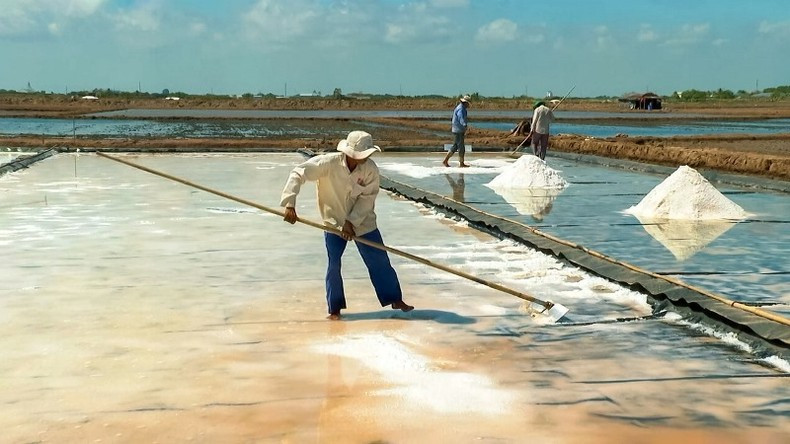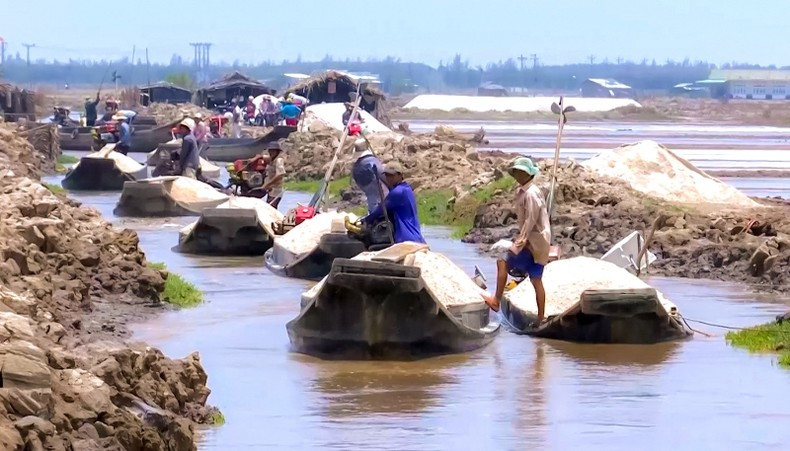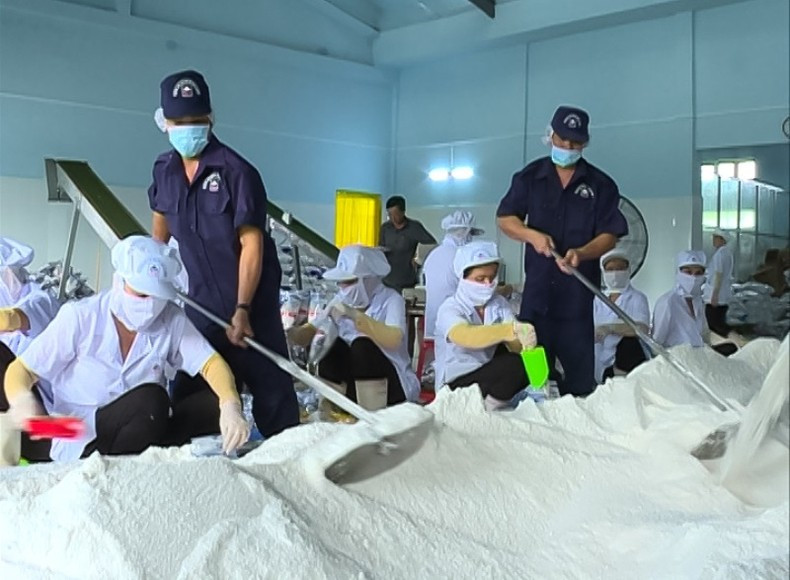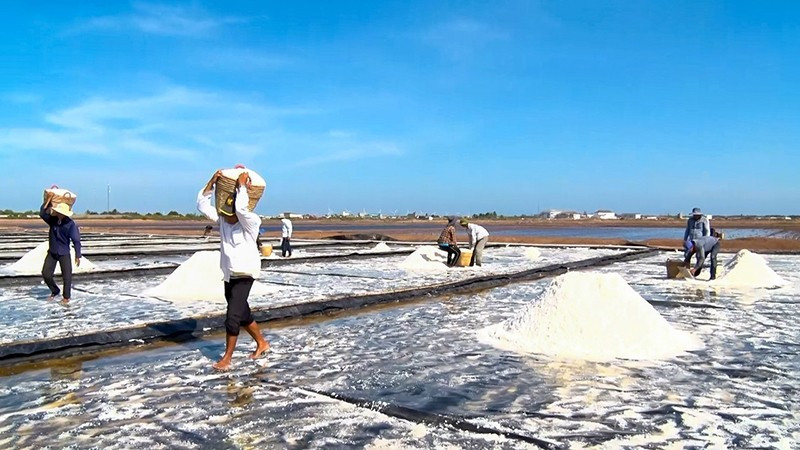In 2020, salt making in Bac Lieu was honoured to be recognised as a national intangible cultural heritage by the Ministry of Culture, Sports and Tourism.
Salty crystallised by hard-working
Thanks to specific ecological conditions and a coastline stretching over tens of kilometres, Bac Lieu has many advantages in forming salt fields stretching from the border with Vinh Chau sea (Vinh Chau Town, Soc Trang Province) to the Ganh Hao Estuary. Many hamlets in Dien Hai Commune, Long Dien Tay, are also called “Salt hamlets” or “Salt farmers hamlets” because hundreds of the families there earn a living by making salt.
Bac Lieu is one of the provinces with the largest salt production areas in the country, with nearly 1,500 hectares, and its annual output reaches more than 15,000 tons. Bac Lieu salt used to be called Ba Thac salt - a famous folk brand associated with the livelihoods of many salt farmers and became a traditional craft of the people of the sea.
 |
| Producing high quality salt by using the plastic tarpaulin method. |
Despite many changes, the Bac Lieu salt craft villages of today still retain their pristine beauty and unique production methods. This field requires salt farmers industriousness along with knowledge and production experience associated with nature. Salt making season usually spans from November to March of the following year according to the lunar calendar.
First step: On the salt field, people will pack the ground tightly to minimise seawater infiltration. Then, they will continue to add seawater to evaporate and increase the soil solidity. When the salt field has met the requirements, the seawater will be poured in.
A salt field with seawater in it is called a “ruong phoi”. Under the sun, the seawater evaporates gradually, increasing the salinity higher than the original water, salt farmers then drain this water into the fields below to create salt, this field is called a “ruong an”, which is prepared by tightly pressing and smoothing the ground.
The main salt production method in Bac Lieu today is still the evaporation method, which depends a lot on the weather, so the number of sunny and rainy days in a year affects the production and quality of the salt.
Visiting the salt fields of Dien Hai Commune, Dong Hai District, we had the opportunity to talk with the salt farmers whose entire lives are spent harvesting salt. At the age of 70, Mr. Tran Van Cong is diligently collecting impurities with his tanned hands standing out on the white salt mound that sparkles in the sun.
 |
| Tradesmen purchase salt in Dien Hai Commune, Dong Hai District. |
He said: “I have been in this career for nearly 30 years, there were many years when salt was only 2,000 dong per ten kilograms, but I am still working until now. In the past, we had to travel nearly 3 km to bring water from the defence dike to this place, we also had to dig a road to bring water to the salt fields, but now thanks to machines, it's no longer as hard as in the period of making an A-frame to slap water into the field....”
“I have been in this career for nearly 30 years, there were many years when salt was only 2,000 dong per ten kilograms, but I am still working until now. In the past, we had to travel nearly 3 km to bring water from the defence dike to this place, we also had to dig a road to bring water to the salt fields, but now thanks to machines, it's no longer hard as in the period of making an A-frame to slap water into the field....”
Mr. Tran Van Cong
In recent years, salt farmers have applied scientific and technical progress to produce high-quality salt by spreading plastic tarpaulin on the crystallisation field. It not only doubles productivity, but also helps salt farmers to sell their salt at a higher price compared to the traditional approach because of the increase in quality.
Dong Hai is the district with the largest salt production area in Bac Lieu with 1,280 hectares, Head of Agriculture and Rural Development Department Ho Thanh Tuan said that in 2020, when it was recognized as a national intangible cultural heritage, salt making has been care and support by the Central region and the province with a total budget of 130 billion VND to invest in infrastructure, build high quality salt fields, and mechanise and modernise salt production, such as with the use of the plastic tarpaulin method.
Mrs. Nguyen Thi Thuy, a salt farmer in Dien Hai Commune, Dong Hai District, said: "Salt made in the traditional way has low price and efficiency, but salt now made by using the plastic tarpaulin method will have quick harvesting and a higher price. To use this method for these four drying yards needs an investment of more than 100 million VND but salt farmers will break even in about 1 year. This year I earned more money by using plastic tarpaulin method. The salt price in previous years was only a few hundred VND/kg, but this year the price is more than 2,000 VND/kg.”
Mr. Nguyen Hong Quoc, Chairman of the Board of Huy Dien Salt making Cooperative (Dien Hai Commune) said that it was necessary to use science and technology such as having machines, investing in tarpaulins in order to decrease the required labour power. His cooperative is also very interested in participating in OCOP to have a product brand, because Bac Lieu salt has a distinctive sweet aftertaste, which is different from others.
More support needed
Although using tarpaulin in the production process is the right direction for sustainable development and white salt production is good, the capital investment for tarpaulin is too large, while most salt farmers don't have enough money to handle it. Typically, in the 2021-2022 harvest, the production area using the tarpaulin method on the crystallisation fields of Dong Hai District was more than 103 hectares, accounting for only about 7% of the total salt production area of the province.
Although Bac Lieu salt is continuing to assert its brand, has a certain position in both domestic and international markets and Bac Lieu salt making craft has been recognised as a national heritage, the life of salt farmers is still facing difficulties and the salt production area is gradually decreasing. In 2011, the whole province had more than 3,000 hectares of production, about 1,300 households directly worked, but by 2015 it had reduced to more than 2,600 hectares and in 2022, only 1,411 hectares remained. Because salt production does not bring high economic efficiency compared to other production models, so many salt farmers have switched to other higher-income ones.
 |
| High quality export salt processing factory in Bac Lieu. |
Over the years, Bac Lieu has issued many support policies, invested in salt field infrastructures in order to keep the traditional craft. The province has approved the proposal raising the value of salt production and processing in the 2021-2030 period, establishing and developing the salt industry in an efficient and sustainable direction to improve the productivity, quality, and diversify of the products, in order to meet domestic demand and towards export, create jobs, raise incomes, and stabilise the living standards for salt farmers.
Currently, Bac Lieu has two salt processing plants with a maximum total capacity of more than 36,000 tons/year; in which some high-quality products have been exported to Japan and Korea. In addition to encouraging people to cooperate in production and apply the plastic tarpaulin production model, in the preliminary processing process, Bac Lieu Salt Joint Stock Company also had the initiative to manufacture a rotary drum dryer machine to decrease salt moisture content from 5 % to less than 1%.
After being dried, salt grains have uniformity in size, bright white colour and salty taste. This initiative has won the first prize at the 6th Provincial Technical Innovation Contest. The rotary drum dryer machine overcomes the disadvantages of the previous horizontal static salt drying and sieve drying such as: intensive labour and fuel consumption, equipment failure, uneven product moisture content.
Director of Bac Lieu Department of Agriculture and Rural Development Luu Hoang Ly expressed optimistically, “With the investment and support from the Ministry in building salt zones infrastructure, Bac Lieu will focus on reinforcing the cooperative economy and local cooperatives. Hopefully in the future, salt will not only produce food but also combine with health and tourism to help people improve their lives and make the salt industry more developed.”
“With the investment and support from the Ministry in building salt zones infrastructure, Bac Lieu will focus on reinforcing the cooperative economy and local cooperatives. Hopefully in the future, salt will not only produce food but also combine with health and tourism to help people improve their lives and make the salt industry more developed.”
Director of Bac Lieu Department of Agriculture and Rural Development Luu Hoang Ly.
Recently, the Ministry of Agriculture and Rural Development has approved the project renovating and upgrading the infrastructure of Dong Hai salt fields (Dong Hai District) with a total capital of more than 100 billion VND. Accordingly, it will renovate and build new more than 15 km of roads and replace four new bridges, serving the production area of more than 1,300 hectares in two communes, Dien Hai and Long Dien Dong.
With the investment, the commune will focus on brand development and consider OCOP participation to bring the Dien Hai salt brand to domestic and international markets. Head of Agriculture and Rural Development Office of Dong Hai District Ho Thanh Tuan shared a nurtured aspiration of craft land that the district is supporting the salt farmers who still persevere with salt making, thereby helping the district building the image of artisans’ worthy of recognition by the State, which in turns helps to preserve the traditional craft for successive generations.
















